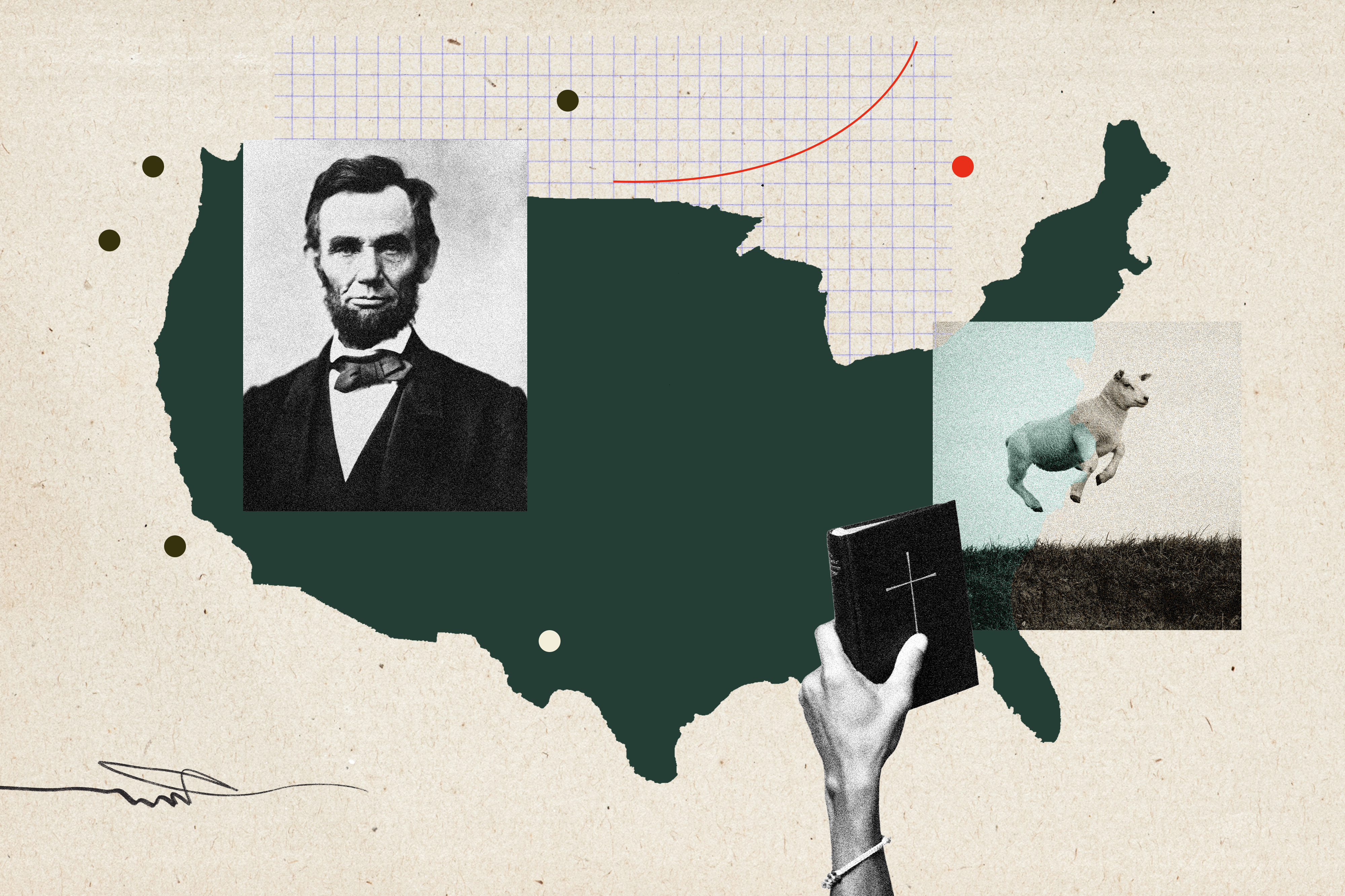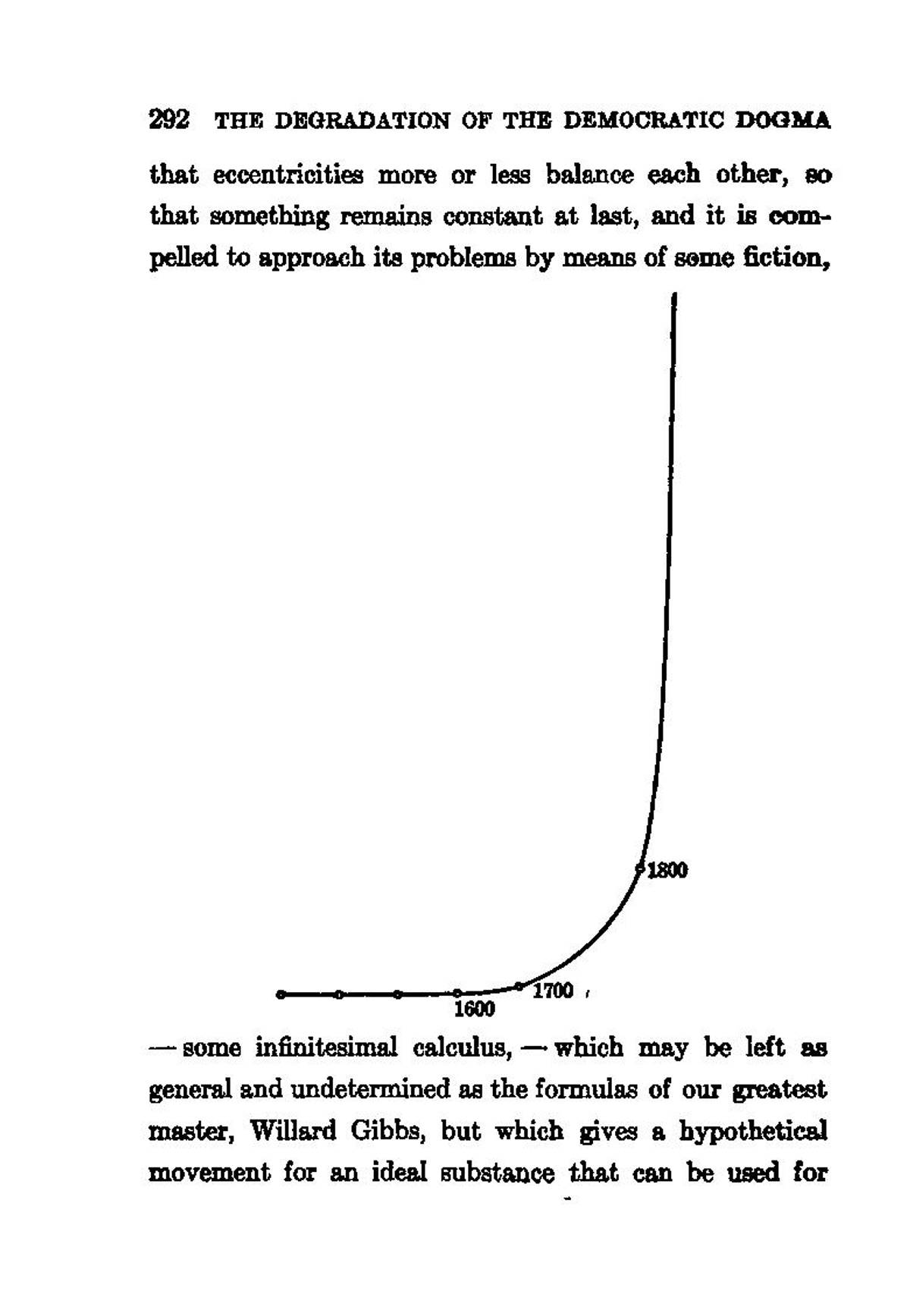Our Singular Century
How to connect the dots when they’re spinning out of control



The American historian Henry Adams was the son of Charles Francis Adams, Abraham Lincoln’s ambassador to Britain during the Civil War who was charged with keeping Britain from intervening on the side of the South. Henry was the grandson of President John Quincy Adams and the great-grandson of President John Adams. Born in 1838 when the railroad was still a novelty, he died in 1918. His histories of the Jefferson and Madison administrations are still read with respect.
It was the acceleration of historical change more than the fact of it that increasingly fascinated Adams as he watched the Industrial Revolution and its associated dislocations unfold around him. Late in his life he set himself the task of quantifying, so far as this was possible, the rate of change as measured by the total amount of physical force that human beings could control. His results have fascinated me for years.
What he found is what we can call the Adams curve. Wind power and human and animal muscle power were the resources at humanity’s disposal for much of our history, and the amount of force humanity could generate grew slowly with population and a slow increase in the mastery of natural forces.
After 1600 his estimates showed the beginning of a faster increase in humanity’s power. The increase visibly accelerates between 1700 and 1800, and between 1800 and 1900 the flat line of earlier centuries takes the shape of a hyperbola as the rate of increase in human power reached for the sky. As Adams put it, “The world did not double or treble its movement between 1800 and 1900, but, measured by any standard known to science—by horse-power, calories, volts, mass in any shape—the tension and vibration and volume and so-called progression of society were fully a thousand times greater in 1900 than in 1800.”
Looking ahead, Adams saw only more of the same, with the curve of human progress becoming more hyperbolic as it became more nearly a vertical line moving straight up the graph. The historian, whose early recollections included walking hand in hand with his grandfather John Quincy Adams to the town school, looked forward to an unrecognizable future in which the gap between pure thought and the material world would close sometime around 2025.
ChatGPT beat his predictions by a few years, but we are now exploring the world that Adams glimpsed from afar more than 100 years ago.

As humanity rode the skyrocketing Adams curve toward the stratosphere during the ensuing century, speculation about the meaning of this development became more widespread, while competing visions of the end state toward which all this activity pointed increasingly preoccupied philosophers, the tech wizards engaged in constructing the new future, ordinary citizens, and even national leaders.
Henry Adams predicted an era in the 21st century in which the rate of change had become so nearly infinite that no one from past eras could hope to describe or understand it. As late 20th- and early 21st-century thinkers followed Adams’ analysis, often unknowingly, they elaborated on this concept, borrowing a term from astrophysics to describe the barrier between present day experience and the unknowable future on the far side of essentially infinite change.
They called that great divide between us and the future a “singularity.” Physicists developed this term to describe what lay inside the event horizon of a so-called black hole, a collapsed star whose density is so great that its escape velocity is greater than the speed of light. Because no light could escape from inside the singularity, those on the outside of the black hole’s event horizon can never really know what is happening inside it. Information cannot come to us from the inside.
Later scientists have somewhat revised that view, given the possibilities of quantum entanglements and other quirky phenomena in this complicated universe, but the analogy is still a compelling one. In Adams’ language, the singularity means the point when the rate of change is so fast that the future is unknowably other than the past. There is an “event horizon” that separates two completely different eras.
When the Silicon Valley tech lords speak of the singularity, they generally refer to an epochal development in the world of IT that fundamentally alters the conditions of human life. The ability to extend our consciousness indefinitely by uploading our personalities and memories into cyberspace would be one example with technological progress essentially abolishing human mortality. The emergence of runaway artificial intelligences that improved their own performance and intelligence so rapidly that human beings would be helpless onlookers in a world run by super-smart machines would be a less pleasant one.

People have, however, imagined other equally dramatic breaks with the past that could also fairly be labeled singularities. The establishment of a truly peaceful and just world order in which technological progress made us all rich while brilliantly designed new global institutions created global justice and world peace would be a decisive break from everything in the past. Advances in medicine could indefinitely prolong human lifespans without the bother and inconvenience of moving one’s consciousness to cyberspace.
Other clean breaks with the past are not as attractive. Runaway climate change, activists warn, could lead to a “condition Venus” that would ultimately cleanse our planet of all life. Or the use of nuclear or biological weapons of mass destruction could drive our guilty species into extinction.
These scenarios are not just the subject of deranged musings by religious fanatics and conspiracy freaks. Since 1945 the question of avoiding a nuclear holocaust has engaged the attention of politicians around the world. Mainstream American thought has historically believed that it was America’s purpose to bring about the “Liberal Singularity,” a point in time in which tyranny, oppression, poverty and war would vanish from human life. Communist and socialist movements offered rival paths toward achieving a total transformation of the human condition. Silicon Valley is filled with tech bros seeking immortality not through their work but, as Woody Allen once put it, by not dying. Climate activists seek to prevent a climate apocalypse in which climate change would disrupt or destroy human civilization. Many of the world’s greatest thinkers, wealthiest entrepreneurs, most committed activists and most senior political leaders see either enabling a positive singularity or staving off a negative one as the central task of their lives.
We live in a singular century. Faced, apparently, with the possibility that the next century could witness either the extinction of humanity or the establishment of a global utopia, both our hopes and our fears tend to be larger than life. Political opponents are not just people with whom we disagree. They are people whose misguided views could destroy the planet. Do ordinary standards of political competition still apply when your opponents’ policies will destroy human civilization? Should they be allowed free speech? Should they be able to organize politically even if their electoral victories would destroy life on Earth?
Living in the shadow of the singularity changes the way politics and society work. It also creates a greater need for intellectual balance and clarity.
ChatGPT beat his predictions by a few years, but we are now exploring the world that Adams glimpsed from afar more than 100 years ago.
Confucius famously taught that social reform had to begin with the rectification of names. Words must correspond to realities, or both the political and social realms will collapse into disorder. Abraham Lincoln concurred, reportedly quoting an old saw to Secretary of State William Seward in an 1862 cabinet meeting. “How many legs does a sheep have,” he asked, “if you count a tail as a leg?”
“Five,” said Seward.
“Wrong,” Lincoln responded. The answer was four—calling a tail a leg doesn’t make it one.
That reactionary, literalist viewpoint would get Lincoln in trouble on some American college campuses today, but Honest Abe was right. Political action must be based on solid facts, clearly seen and frankly named. But Americans today don’t just need to know what the facts are. We need to understand what they mean. We don’t just need a rectification of names. We need a clarification of narratives.
It is narrative that gives meaning to facts. Kids draw lines in connect-the-dots activity books to turn an apparently unrelated set of spots on the page into the drawing of a zebra or a butterfly. As they grow up, they learn to make sense of events around them by relating them to larger stories. That’s how detectives solve crimes—connecting the dots.
Many of our political conflicts today are less about the dots than about how to connect them. If we embrace the 1619 Project narrative, in which racism and slavery are seen as the principal drivers of American history and values, we see America as a monster. If we embrace a narrative that sees American history, however imperfect, as a story of progress and moral improvement we draw a very different picture.
Those debates matter, but I don’t think America’s biggest problem is that we are divided between two coherent but opposed worldviews. Our problem is deeper. There are so many dots, and so many of them seem to be moving around the page, that it is getting harder to draw any kind of picture at all.
I see a lot of young people in my work and continue to be astounded at how intelligent, mature, and wide awake so many of them are. I’m also astounded at how confused and bewildered so many of them feel amid the explosive change and careening events that characterize our dizzying century. Their distress is a reasonable response to an unreasonable era. Anyone whose psychic equilibrium has not been challenged by the cultural and political earthquakes testing the cohesion of our society and civilization has not been paying attention.
But while confusion and bewilderment may be appropriate responses to tumultuous times, they are not enough. All of us, and especially the younger generations on whom the full burden of the future must inevitably fall, need to develop the lucidity of thought and the steadiness of character required for effective action in a society that staggers and lurches through our chaotic era like a drunk sailor in rough seas on a slick deck.
In times like these, people hunger for explanations—for a way of connecting the dots to make sense out of the cascade of events. This is why we live in an age of conspiracy theories. Those theories are often desperate attempts to make sense of an unpredictable and terrifying world. It might be depressing to think that the world is controlled by lizard people, by the Bavarian Illuminati, by the Elders of Zion, the Deep State or a grand corporate conspiracy, but at least one has the comfort of knowing who the singular enemy is. Knowledge gives power, and even the illusion of knowledge that comes from embracing a conspiracy theory can feel empowering, at least for a while.
Like everybody else, I struggle to keep my emotional and intellectual balance in these difficult conditions, and while I haven’t bought into the various attractively cinematic conspiracy theories flashing over the internet, I do find it important to have some way of connecting the dots and making sense of the world. For me, what works is not a grand ideology like Marxism that purports to combine a single unified explanation for everything that is going on with a method of shaping history toward the desired conclusion. The 20th century was littered with the corpses produced by these naively self-confident ideological fever dreams, and I can see no good coming out of a return to them. And I’ve seen too much of the way the world really works and have come to know too many of the people and the institutions singled out by the conspiracy mongers to credit “the Jews,” “the bankers,” “the deep staters,” or any of these other popular villains with the wisdom or the cunning needed to rule the world.
Others look to religion to provide a clear and all-encompassing explanation of world events, and an easily understood method for dividing out the good guys and the bad. This approach also falls short. As a Christian, admittedly a rather imperfect one, I believe that we all benefit from God’s providence and live under his judgment, and that when properly seen and understood the tangled threads of human history will ultimately reveal the work of a divine hand. But my faith also teaches me that, as C.S. Lewis put it in the Narnia books, Aslan is not a tame lion. Faith in God can help you find the inner strength to face the storms of history with courage and resolve, but the Christian revelation is intended to lead people toward a deeper engagement with the mystery and the wonder of the universe. Those who look for point-by-point guides to a coming apocalypse in the Christian scriptures, or those who think that a simplistic reading of the ethical teachings of Christ eliminates the need for hard political thinking are missing the point. Christianity—and in this it resembles all the great religious traditions—exists to enrich and to complicate rather than to simplify our understanding of the contemporary world.
What 20th-century ideologies, 21st-century conspiracy theories, and naive readings of religious teaching have in common is a kind of ChatGPT approach to the contemporary world. That is, they present themselves as an intellectual machine that will pop out an answer for every question they are asked. A universal answer machine is a handy thing to have, and one can understand why so many people derive so much comfort and satisfaction from having them.
But are such machines what we really need?
The narrative frameworks that interest me most these days aren’t the ones that purport to work like AI chatbots, offering unfailing answers to all the problems we face. They work more like filters, helping me sort out the real news from the faux news and the news fluff, and they act like good binoculars, enabling me to see details that I would otherwise miss. I’m looking for frameworks that give me the perspective and context that lead to smart questions. And as I struggle to make sense out of the torrent of events in both domestic and international life, I’m increasingly drawn to three complementary “big picture” narrative frameworks that put American and world events in a helpful perspective.
The first, oldest, and most universal story is the one with which we started: the gradual development of the technological capabilities and cultural complexity of human society going back to the first grunting flint chippers at the dawn of human time. The second, much more recent and fast-moving story is the rise and spread of Abrahamic religion and politics, a process that began thousands of years ago with the rise of monotheism in the Middle East and that continues to the present day. The youngest and fastest moving story is the rise of global capitalism under the auspices of the two successive English-speaking world powers: the British Empire and the United States.
Taken separately, each of these narratives casts light on the exceptional and unique nature of the times that we live in. Taken together, they enrich our understanding while pointing us toward ways of imagining and building a brighter future. Abrahamic religion and politics rise out of the larger, older drive toward technological mastery and social complexity. From the first emergence of the Abrahamic worldview in the ancient Middle East, the complicated legacy of the ancient patriarch has acted as an intensifier and accelerant, dramatically expediting the development of human culture even as it stimulates the continuing advance of humanity’s understanding of and mastery over natural forces. Similarly, the rise of the capitalist world order under Anglo-American auspices emerges out of the older two stories, and in its turn it both accelerates and intensifies processes that were already at work.
Engagement with these three narratives has been a feature of my work for many years. Readers of both God and Gold: Britain, America and the Making of the Modern World and my most recent book, The Arc of a Covenant: The United States, Israel and the Fate of the Jewish People, will recognize some of these ideas. As Via Meadia 2.0 works to identify some positive steps that Americans can take on the way toward renewing the promise of American life, we’ll also be looking at these framing narratives. That’s partly because I think readers deserve to see and, should they choose, to contest the underlying assumptions behind the ideas and proposals to be discussed here. And it’s partly because I think looking at the ways I’ve used history and culture to sharpen my analysis of contemporary politics will help readers trying to figure these things out for themselves.
In my next essay, I’ll begin at the beginning, with the oldest and most universal of the three: the technological and social development that we find at work virtually everywhere in human history and prehistory that we look—and that we often, for lack of a better word, call progress. Henry Adams wanted to understand the impact that the Industrial Revolution would have on his world. Examining the widespread and consequential impacts of earlier revolutions can help us keep our heads as the Information Revolution transforms our society.
Walter Russell Mead is the Ravenel B. Curry III Distinguished Fellow in Strategy and Statesmanship at Hudson Institute, the James Clarke Chace Professor of Foreign Affairs and Humanities at Bard College, and the Global View Columnist at The Wall Street Journal. He co-hosts What Really Matters, a weekly news and history podcast from Tablet Studios.